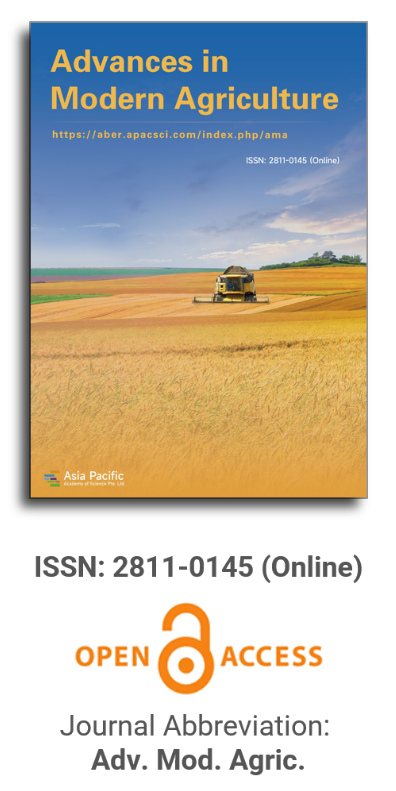


Growth of horned melon (Cucumis metuliferus) under different levels of Trichoderma-based bio-fertilizer
Vol 4, Issue 2, 2023
VIEWS - 4401 (Abstract)
Download PDF
Abstract
Implementing practices such as organic agriculture, sustainable agriculture, or ecological agriculture can greatly reduce and eliminate the harmful effects of synthetic fertilizers on both human health and the environment. In efforts to promote a more environmentally friendly approach, this study was conducted at the Department of Horticulture and Agronomy, Midlands State University in Zimbabwe. The focus was on the use of Trichoderma bio-fertilizer at various levels to determine its impact on the growth of horned melon (Cucumis metuliferus) in a greenhouse setting. The experiment followed a Complete Randomized Design (CRD) and included four different Trichoderma-based biofertilizer treatments, as well as a control treatment [0 g/pot (control), 0.1 g/pot, 0.2 g/pot, 0.3 g/pot, and 0.4 g/pot], all replicated four times. The research findings indicate that the biofertilizer utilized had a significant impact (p ≤ 0.05) on vine length, number of leaves, and branches for growth characteristics. However, the biofertilizer did not have a significant effect (p ≥ 0.05) on stem girth, chlorophyll content, or branching pattern. This study reveals that the horned melon plants treated with the Trichoderma-based biofertilizer exhibited noticeable changes in their vegetative growth, flowering patterns, and fruiting features at different application levels. Further investigation is required to fully understand the potential benefits of using Trichoderma-based biofertilizer in horned melon cultivation.
Keywords
References
- Mugwendere T, Mtaita T, Mutetwa M, Tabarira J. Use of vermicompost assoil supplement on growth and yield of Rape (Brassica napus). Journal of Global Innovations in Agricultural and Social Sciences 2015; 3(1): 25–31. doi: 10.17957/jgiass/3.1.701
- Murunga SI, Wafula EN, Sang J. The use of freshwater sapropel in agricultural production: A new frontier in Kenya. Advances in Agriculture 2020; 2020: 1–7. doi: 10.1155/2020/8895667
- Chaka BA, Osano AM, Maghanga JK, et al. Optimization of bioslurry—Available plant nutrients using T. brownii and Acanthaceae spp. biocatalysts. Advances in Agriculture 2020; 2020: 1–12. doi: 10.1155/2020/4526485
- Alengebawy A, Abdelkhalek ST, Qureshi SR, et al. Heavy metals and pesticides toxicity in agricultural soil and plants: Ecological risks and human health implications. Toxics 2021; 9(3): 42. doi: 10.3390/toxics9030042
- Mavura M, Mtaita T, Mutetwa M, Musimbo N. Influence of vermicom posted soil amendments on plant growth and dry matter partitioning in seedling production. International Journal of Horticulture and Ornamental Plants 2017; 3(1): 037–046.
- Aboudrare A. Agronomie Durable. Principes ET Pratiques. Rapport de Formation Continue; 2009.
- Sutton MA, Bleeker A, Howard CM, et al. Our Nutrient World: The Challenge to Produce More Food and Energy with Less Pollution. Centre for Ecology and Hydrology (CEH); 2013.
- GhoshN. Promoting Bio-fertilizers in Indian Agriculture. Institute of Economic Growth University Enclave; 2003.
- Amutha AI. The Growth Kinetics of Arachis Hypogaea L. Var. TMV-7 under the Inoculation of Biofertilizers with Reference to Physiological and Biochemical Studies [PhD thesis]. Manonmaniam Sundaranar University; 2011.
- Choudhury ATMA, Kennedy IR. Prospects and potentials for systems of biological nitrogen fixation in sustainable rice production. Biology and Fertility of Soils 2004; 39(4): 219–227.
- Malik AA, Sanghmitra S, Javed A. Chemical vs. organic cultivation of medicinal and aromatic plants: The choice is clear. International Journal of Medicinal and Aromatic Plants 2011; 1(1): 5–13.
- Nyaera K, Mtaita TA, Mutetwa M, Masaka T. Influence of maize seed inoculation with microbial bio fertilizers on morphological and physiological parameters of maize. International Journal of Science & Healthcare Research 2019; 4(4): 31–37.
- Hedge DM, Dwivedi BS, Sudhakara Babu SS. Biofertilizers for cereal production in India—A review. Indian Journal of Agricultural Research 1999; 69(2): 73–83.
- Guda T, Mtaita TA, Mutetwa M, et al. Plant growth promoting bacteria-fungi as growth promoter in wheat production. Journal of Asian Scientific Research 2020; 10(3): 141–155. doi: 10.18488/journal.2.2020.103.141.155
- Mazid M, Khan TA. Future of bio-fertilizers in Indian agriculture: An overview. International Journal of Agricultural and Food Research 2014; 3(3). doi: 10.24102/ijafr.v3i3.132
- Subba Rao NS. Biofertilizers in Agricultures and Forestry. Oxford & IBH Publishing; 1993.
- Harman GE, Howell CR, Viterbo A, et al. Trichoderma species—Opportunistic, avirulent plant symbionts. Nature Reviews Microbiology 2004; 2(1): 43–56. doi: 10.1038/nrmicro797
- Singh A, Sarma BK, Singh HB, et al. Trichoderma. Biotechnology and Biology of Trichoderma. Newnes; 2014. doi: 10.1016/b978-0-444-59576-8.00040-0
- Debnath S, Chakraborty G, Dutta SS, et al. Potential of Trichoderma species as biofertilizer and biological control on Oryza sativa L. cultivation. Plant Biotechnology 2020; 20(1): 1–16.
- Kurrey D, Singh RK, Rajput RS. Effect of Hydrogel and Trichoderma on root growth and water productivity in rice varieties under rainfed conditions. Research Journal of Agricultural Sciences 2018; 9: 210–212.
- Mahmood A, Kataoka R. Potential of biopriming in enhancing crop productivity and stress tolerance. In: Advances in Seed Priming. Springer; 2018.
- Mtaita TA, Nyaera K, Mutetwa M, Masaka T. Effect of bio fertilizer with varying levels of mineral fertilizer on maize (Zea mays. L) growth. Galore International Journal of Applied Sciences & Humanities 2019; 3(4): 1–9.
- Mutetwa M, Nyaera K, Masaka T, Mtaita TA. Effect of bio priming seeds with microbial based bio fertilizers on growth of maize seedlings. International Journal of Research and Review 2019, 6(10):281–288.
- Sani MdNH, Hasan M, Uddain J, et al. Impact of application of Trichoderma and biochar on growth, productivity and nutritional quality of tomato under reduced N-P-K fertilization. Annals of Agricultural Sciences 2020; 65(1): 107–115. doi: 10.1016/j.aoas.2020.06.003
- Wanjiku EK, Waceke JW, Mbaka JN. Suppression of stem-end rot on avocado fruit using Trichoderma spp. in the central highlands of Kenya. Advances in Agriculture 2021; 2021: 1–6. doi: 10.1155/2021/8867858
- Chianu JN, Nkonya EM, Mairura FS, et al. Biological nitrogen fixation and socioeconomic factors for legume production in sub-Saharan Africa: A review. Agronomy for Sustainable Development 2011; 31(1): 139–154. doi: 10.1051/agro/2010004
- Zin NA, Badaluddin NA. Biological functions of Trichoderma spp. for agriculture applications. Annals of Agricultural Sciences 2020; 65(2): 168–178. doi: 10.1016/j.aoas.2020.09.003
- Zaidi MW, Singh M, Kumar S, et al. Trichoderma harzianum improves the performance of stress tolerant rice varieties in rain fed ecologies of Bihar, India. Field Crops Research 2018; 220: 97–104. doi: 10.1016/j.fcr.2017.05.003
- Dobbelaere S, Vanderleyden J, Okon Y. Plant growth-promoting effects of diazotrophs in the rhizosphere. Critical Reviews in Plant Sciences 2003; 22(2): 107–149. doi: 10.1080/713610853
- Selvakumar G, Lenin M, Thamizhiniyan P, Ravimycin T. Response of biofertilizers on the growth and yield of black gram. Recent Research in Science and Technology 2009; 1: 169.
- Li RX, Cai F, Pang G, et al. Solubilisation of phosphate and micronutrients by Trichoderma harzianum and its relationship with the promotion of tomato plant growth. PLoS One 2015; 10(6): e0130081. doi: 10.1371/journal.pone.0130081
- Halifu S, Deng X, Song X, et al. Effects of two Trichoderma strains on plant growth, rhizosphere soil nutrients, and fungal community of Pinus sylvestris var. mongolica annual seedlings. Forests 2019; 10(9): 758. doi: 10.3390/f10090758
- El-Mansi AA, Bardisi A, El-Atabany SA. Effect of Rhizobium and soil plastic mulch on nodulation, plant growth and yield of pea under sandy soil conditions. Zagazig Journal of Agricultural Research 2000; 27: 899–912.
- Bashan Y, Bustillos JJ, Leyva LA, et al. Increase in auxiliary photoprotective photosynthetic pigments in wheat seedlings induced by Azospirillum brasilense. Biology and Fertility of Soils 2005; 42(4): 279–285. doi: 10.1007/s00374-005-0025-x
- Mahato S, Neupane S. Comparative study of impact of Azotobacter and Trichoderma with other fertilizers on maize growth. Journal of Maize Research and Development 2018; 3(1): 1–16. doi: 10.3126/jmrd.v3i1.18915
- Chirino-Valle I, Kandula D, Littlejohn C, et al. Potential of the beneficial fungus Trichoderma to enhance ecosystem-service provision in the biofuel grass Miscanthus x giganteus in agriculture. Scientific Reports 2016; 6(1). doi: 10.1038/srep25109
- Liu B, Ji S, Zhang H, et al. Isolation of Trichoderma in the rhizosphere soil of Syringa oblata from Harbin and their biocontrol and growth promotion function. Microbiological Research 2020; 235: 126445. doi: 10.1016/j.micres.2020.126445
- Sutton JC. Trichoderma koningii as a parasite of maize seedlings. Canadian Journal of Plant Science 1972; 52(6): 1037–1042. doi: 10.4141/cjps72-176
- Mcfadden AG, Sutton JC. relationships of populations of Trichoderma spp. in soil to disease in maize. Canadian Journal of Plant Science 1975; 55(2): 579–586. doi: 10.4141/cjps75-085
- Menzies JG. A strain of Trichoderma viride pathogenic to germinating seedlings of cucumber, pepper, and tomato. Plant Pathology 1993; 42: 784–791. doi: 10.1111/j.1365- 3059.1993.tb01565
- Chacón MR, Rodríguez Galán O, Benítez Fernández CT, et al. Microscopic and transcriptome analyses of early colonization of tomato roots by Trichoderma harzianum. International Microbiology 2007; 10: 19–27.
- Dorais M. Organic production of vegetables: State of the art and challenges. Canadian Journal of Plant Science 2007; 87(5): 1055–1066. doi: 10.4141/cjps07160
- Kotasthane A, Agrawal T, Kushwah R, et al. In-vitro antagonism of Trichoderma spp. against Sclerotium rolfsii and Rhizoctonia solani and their response towards growth of cucumber, bottle gourd and bitter gourd. European Journal of Plant Pathology 2014; 141(3): 523–543. doi: 10.1007/s10658-014-0560-0
- Zeilinger S, Gruber S, Bansal R, et al. Secondary metabolism in Trichoderma—Chemistry meets genomics. Fungal Biology Reviews 2016; 30(2): 74–90. doi: 10.1016/j.fbr.2016.05.001
- Kleifeld O, Chet I. Trichoderma harzianum? Interaction with plants and effect on growth response. Plant and Soil 1992; 144(2): 267–272. doi: 10.1007/bf00012884
- Wang C, Knill E, Glick BR, et al. Effect of transferring 1-aminocyclopropane-1-carboxylic acid (ACC) deaminase genes into Pseudomonas fluorescens strain CHA0 and its gacA derivative CHA96 on their growth-promoting and disease-suppressive capacities. Canadian Journal of Microbiology 2000; 46(10): 898–907. doi: 10.1139/w00-071
- Sood M, Kapoor D, Kumar V, et al. Trichoderma: The “secrets” of a multitalented biocontrol agent. Plants 2020; 9(6): 762. doi: 10.3390/plants9060762
- Altomare C, Norvell WA, Björkman T, et al. Solubilization of phosphates and micronutrients by the plant-growth-promoting and biocontrol fungus Trichoderma harzianum Rifai 1295-22. Applied and Environmental Microbiology 1999; 65(7): 2926–2933. doi: 10.1128/aem.65.7.2926-2933.1999
Supporting Agencies
Copyright (c) 2023 Moses Mutetwa, Tuarira Mtaita, Wonder Ngezimana, Paul Chaibva
License URL: https://creativecommons.org/licenses/by/4.0/

This site is licensed under a Creative Commons Attribution 4.0 International License (CC BY 4.0).

Prof. Zhengjun Qiu
Zhejiang University, China

Cheng Sun
Academician of World Academy of Productivity Science; Executive Chairman, World Confederation of Productivity Science China Chapter, China
Indexing & Archiving
In the realm of modern agriculture, the integration of cutting-edge technologies is revolutionizing the way we approach sustainable farming practices. A recent study published in Advances in Modern Agriculture titled "Classification of cotton water stress using convolutional neural networks and UAV-based RGB imagery" has garnered significant attention for its innovative approach to precision irrigation management. Conducted by researchers from Institute of Data Science and the AgriLife Research and Extension Center of Texas A&M University (authors's information is below). This study introduces a novel method for classifying cotton water stress using unmanned aerial vehicles (UAVs) and convolutional neural networks (CNNs), offering a powerful solution for optimizing water use in agriculture.
Modern agricultural technology is evolving rapidly, with scientists collaborating with leading agricultural enterprises to develop intelligent management practices. These practices utilize advanced systems that provide tailored fertilization and treatment options for large-scale land management.
This journal values human initiative and intelligence, and the employment of AI technologies to write papers that replace the human mind is expressly prohibited. When there is a suspicious submission that uses AI tools to quickly piece together and generate research results, the editorial board of the journal will reject the article, and all journals under the publisher's umbrella will prohibit all authors from submitting their articles.
Readers and authors are asked to exercise caution and strictly adhere to the journal's policy regarding the usage of Artificial Intelligence Generated Content (AIGC) tools.
Asia Pacific Academy of Science Pte. Ltd. (APACSCI) specializes in international journal publishing. APACSCI adopts the open access publishing model and provides an important communication bridge for academic groups whose interest fields include engineering, technology, medicine, computer, mathematics, agriculture and forestry, and environment.



.jpg)
.jpg)

.jpg)
